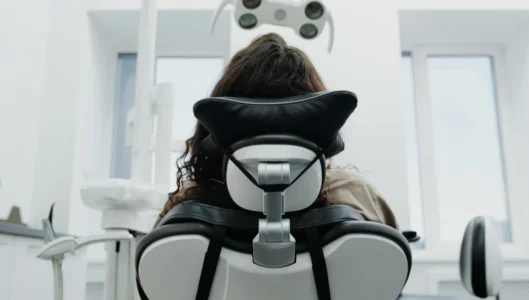The dental industry has seen remarkable technological advancements over the years, with significant transformations in dental equipment and patient care. From humble beginnings with simple hand tools like chisels and forceps, the field of dentistry has evolved into a high-tech realm, driven by digital innovation and advanced engineering. The current state of dental equipment combines cutting-edge digital imaging, automation, robotics, and artificial intelligence (AI), all aimed at improving diagnostic accuracy, treatment efficiency, and patient outcomes.
A Look Back: Early Stages of Dental Equipment
Historically, dentistry was a hands-on craft, relying on rudimentary tools to treat patients. Even in the early 20th century, procedures like extractions, fillings, and cleanings were carried out using manual tools, with limited support from technology. Dentists often relied on their own training and experience to determine the extent of a patient’s condition, frequently using basic X-ray machines and physical inspection methods to diagnose and treat oral diseases.
However, the 1980s and 1990s marked the beginning of significant shifts in dental equipment. Digital X-rays, lasers, and CAD/CAM (Computer-Aided Design and Computer-Aided Manufacturing) systems began to transform how dental practices operated. The integration of technology allowed for faster, more accurate diagnoses and treatments, reducing the discomfort and recovery time for patients.
Current Innovations: Digital Imaging and CAD/CAM Systems
One of the most notable changes in modern dentistry has been the advent of digital X-rays. Compared to traditional film-based X-rays, digital imaging provides faster results, less radiation exposure for patients, and the ability to store images electronically for easy access. Digital X-rays also allow dentists to manipulate and zoom in on specific areas of the image, providing a clearer view of problem areas like cavities or gum disease.
In parallel, CAD/CAM systems have revolutionized restorative dentistry by enabling the creation of crowns, bridges, and dentures in a fraction of the time it used to take. With CAD/CAM technology, dental professionals can design, customize, and produce dental restorations within a single appointment, reducing the need for multiple office visits. This technology has also reduced the number of impressions needed, which can be uncomfortable for patients.
Artificial Intelligence and Diagnostic Accuracy
AI’s role in dentistry has grown significantly in recent years. AI-powered software tools are being used for everything from predictive analytics to diagnostic imaging. In diagnostic imaging, AI tools are able to analyze X-rays, 3D scans, and other images with an accuracy that exceeds human abilities. A 2023 survey by the American Dental Association (ADA) found that 45% of dental practitioners had integrated AI-based diagnostic tools into their practices, and this number is steadily growing.
AI helps detect early signs of oral diseases such as cavities, gum disease, and oral cancer with higher precision. The system compares scans against a vast database of known conditions, identifying abnormalities that might be missed by the human eye. Additionally, AI can help in treatment planning by analyzing patient data, suggesting the best course of action for the specific condition.
Challenges of the Future: Data Security, Training, and Cost
Despite the clear advantages of advanced dental equipment, challenges remain, especially when it comes to data privacy and security. With the increasing reliance on digital tools, sensitive patient data is being stored electronically, raising concerns about potential data breaches or unauthorized access. Dental practices must invest in robust cybersecurity measures to ensure patient data is protected.
Moreover, the introduction of AI and new technologies requires continuous training for dental professionals. While these advancements provide substantial benefits, they also demand an understanding of complex software and systems. Dental professionals must dedicate time to keeping up-to-date with the latest innovations, which can be a significant time and financial investment.
The cost of implementing cutting-edge dental equipment can also be prohibitive for smaller practices, limiting their ability to offer the best possible care. However, as the technologies continue to improve and become more widespread, prices are expected to decrease, making them more accessible.
Looking Ahead: The Future of Dental Equipment
The future of dental equipment is undoubtedly tied to the continued advancement of AI, robotics, and digital technology. In the coming years, AI may play an even larger role in diagnosis, treatment planning, and patient monitoring. Innovations like 3D printing, which allows for the creation of customized dental implants and prosthetics, will become more prevalent, further improving patient care.
As dental technology continues to evolve, it will help drive improvements in patient outcomes, reduce costs, and enhance the overall efficiency of dental practices. However, these advances will also require ongoing education and adaptation for dental professionals. With the right balance of technology and expertise, the future of dentistry is promising, offering greater precision, better patient care, and a more efficient healthcare system.




miaqueen
April 22, 2021It’s a great pleasure reading your post!
cmsmasters
April 22, 2021Thanks.
Lilly4687
July 25, 2025https://shorturl.fm/mJzTz
Katelyn1700
July 25, 2025https://shorturl.fm/2zME1
Millie760
July 25, 2025https://shorturl.fm/Yqm89
Lewis3239
July 26, 2025https://shorturl.fm/pxjbc
Elliott2273
July 26, 2025https://shorturl.fm/8IR1v
Claudia3318
July 26, 2025https://shorturl.fm/1pn8P
Colt4909
July 27, 2025https://shorturl.fm/2u7UD
Erik170
July 27, 2025https://shorturl.fm/57BsE
Roberto286
July 27, 2025https://shorturl.fm/tw1Yz
London988
July 28, 2025https://shorturl.fm/neNtG
Antonio522
July 29, 2025https://shorturl.fm/dpBwN
Nelly4451
July 29, 2025https://shorturl.fm/KgERN
Beth211
July 30, 2025https://shorturl.fm/xPltS
Delaney1372
July 30, 2025https://shorturl.fm/myHra
Paul3909
July 30, 2025https://shorturl.fm/T1NME
Lee1313
July 30, 2025https://shorturl.fm/a73HH
Marcel489
July 30, 2025https://shorturl.fm/3pEbM
Brooke1344
July 30, 2025https://shorturl.fm/flwjI
Justin707
July 30, 2025https://shorturl.fm/46Z2G
Brittany153
July 31, 2025https://shorturl.fm/1f690
Harold2085
July 31, 2025https://shorturl.fm/KRJV3
Arlo3806
July 31, 2025https://shorturl.fm/MjslR
Hazel4559
July 31, 2025https://shorturl.fm/LIRR1
Christina449
August 2, 2025https://shorturl.fm/ocsH9
Hank1812
August 2, 2025https://shorturl.fm/ocsH9
Lila3202
August 2, 2025https://shorturl.fm/cUKMK
Howard2712
August 2, 2025https://shorturl.fm/lBYPm
Cassandra3992
August 2, 2025https://shorturl.fm/jkVIP
Cora726
August 2, 2025https://shorturl.fm/vq2Y5
Bailey4073
August 3, 2025https://shorturl.fm/sZsAl
Caleb3800
August 3, 2025https://shorturl.fm/gjoEC
Cristian4823
August 3, 2025https://shorturl.fm/jHmYj
Grant4152
August 4, 2025https://shorturl.fm/THFls
Lara1872
August 4, 2025https://shorturl.fm/LfvZt
Haiden437
August 4, 2025https://shorturl.fm/w2FEf
Anthony2614
August 4, 2025https://shorturl.fm/jDKh7
Stephen2702
August 4, 2025https://shorturl.fm/tPGPT
Camille2544
August 5, 2025https://shorturl.fm/xGqyn
Melody4614
August 8, 2025https://shorturl.fm/5IaRR
Martin3545
August 8, 2025https://shorturl.fm/vj8f3
Molly2474
August 8, 2025https://shorturl.fm/1CiZA
Tristan720
August 9, 2025https://shorturl.fm/IBas3
Daphne3068
August 11, 2025https://shorturl.fm/Q3ULn
Cooper2352
August 12, 2025https://shorturl.fm/tzQCC
Francis3292
August 13, 2025https://shorturl.fm/ogrlX
Arthur1153
August 17, 2025https://shorturl.fm/NwQ9C
Elvira3331
August 19, 2025https://shorturl.fm/xsVoc
Bennett107
August 20, 2025https://shorturl.fm/lSsej
Roger1082
August 22, 2025https://shorturl.fm/L11EJ
bursa seo
August 24, 2025siteniz çok güzel devasa bilgilendirme var aradığım herşey burada mevcut çok teşekkür ederim
bursa seo
August 25, 2025siteniz harika başarılarınızın devamını dilerim aradığım herşey bu sitede
bursa seo
August 25, 2025siteniz çok güzel devasa bilgilendirme var aradığım herşey burada mevcut çok teşekkür ederim
bursa seo
August 27, 2025siteniz çok güzel devasa bilgilendirme var aradığım herşey burada mevcut çok teşekkür ederim
Julius223
August 29, 2025https://shorturl.fm/c0LOu
Gabriella4197
August 29, 2025https://shorturl.fm/RBqqx
bursa seo
August 30, 2025siteniz çok güzel devasa bilgilendirme var aradığım herşey burada mevcut çok teşekkür ederim
bursa araç kamerası
August 31, 2025Harika bir yazı olmuş, teşekkürler. Özellikle Bursa’nın yoğun trafiğinde neyle karşılaşacağımız belli olmuyor. Olası bir durumda elimde kanıt olması için kaliteli bir bursa araç kamerası almayı düşünüyorum. Bu yazı karar vermemde çok yardımcı oldu.
bursa araç kamerası
August 31, 2025Bilgiler için çok sağ olun. Ben özellikle park halindeyken de kayıt yapabilen bir model arıyordum. Nilüfer gibi kalabalık yerlerde park etmek büyük sorun. Sanırım benim için en ideali hareket sensörlü bir bursa araç kamerası olacak.
bursa araç kamerası
August 31, 2025Geçen ay küçük bir kazaya karıştım ve haklı olmama rağmen ispatlamakta zorlandım. O günden sonra hemen bir bursa araç kamerası araştırmaya başladım. Keşke bu olayı yaşamadan önce bu yazıyı okuyup önlemimi alsaydım.
bursa araç kamerası
August 31, 2025Ben profesyonel olarak direksiyon sallıyorum ve güvenlik benim için ilk sırada. Şirket araçlarımızın hepsinde olduğu gibi şahsi aracıma da bir bursa araç kamerası taktırmak istiyorum. Hem caydırıcı oluyor hem de olası bir durumda sigorta süreçlerini hızlandırıyor.
bursa araç kamerası
August 31, 2025Yazınızda bahsettiğiniz G-sensör özelliği çok mantıklı. Allah korusun bir kaza anında o paniğe kapılıp kaydı korumayı unutabiliriz. Bu özelliği olan bir bursa araç kamerası bakacağım, aydınlattığınız için sağ olun.
bursa araç kamerası
August 31, 2025Bilgiler için çok sağ olun. Ben özellikle park halindeyken de kayıt yapabilen bir model arıyordum. Nilüfer gibi kalabalık yerlerde park etmek büyük sorun. Sanırım benim için en ideali hareket sensörlü bir bursa araç kamerası olacak.
bursa araç kamerası
September 1, 2025Bilgiler için çok sağ olun. Ben özellikle park halindeyken de kayıt yapabilen bir model arıyordum. Nilüfer gibi kalabalık yerlerde park etmek büyük sorun. Sanırım benim için en ideali hareket sensörlü bir bursa araç kamerası olacak.
bursa araç kamerası
September 1, 2025Bursa gibi büyük ve hareketli bir şehirde araç kullanmak ekstra dikkat gerektiriyor. Bir bursa araç kamerası kullanarak sadece kendimizi değil, trafikteki diğer masum sürücüleri de korumuş oluruz. Kesinlikle her araçta olması gereken bir cihaz.
bursa araç kamerası
September 1, 2025Bilgiler için çok sağ olun. Ben özellikle park halindeyken de kayıt yapabilen bir model arıyordum. Nilüfer gibi kalabalık yerlerde park etmek büyük sorun. Sanırım benim için en ideali hareket sensörlü bir bursa araç kamerası olacak.
bursa araç kamerası
September 1, 2025Bu kameraların fiyatları hakkında biraz araştırma yapmıştım. Yazınızda belirttiğiniz özelliklere sahip, uygun fiyatlı bir bursa araç kamerası bulmak mümkün müdür? Fiyat/performans ürünü arayanlar için tavsiyelerinizi bekliyorum.
bursa araç kamerası
September 1, 2025Arkadaşımın aracındaki kameranın kaydettiği bir olay sayesinde büyük bir haksızlıktan kurtulduğunu gördüm. O günden beri en kısa zamanda bir bursa araç kamerası almayı planlıyordum. Yazınız bu süreci hızlandıracak.
bursa araç kamerası
September 1, 2025Yazın aracımızla uzun bir Karadeniz turu planlıyoruz. Yol boyunca hem güvenlik hem de hatıra olması için yüksek depolama kapasitesine sahip bir bursa araç kamerası edinmek istiyoruz. Bu yazı tam zamanında karşıma çıktı.
bursa araç kamerası
September 1, 2025Benzer bir ürün kullanıyorum ve kesinlikle herkese tavsiye ederim. Özellikle Organize Sanayi Bölgesi trafiğinde sabah ve akşam saatlerinde çok faydasını gördüm. İyi bir bursa araç kamerası gerçekten hayat kurtarabilir.
bursa araç kamerası
September 1, 2025Ben profesyonel olarak direksiyon sallıyorum ve güvenlik benim için ilk sırada. Şirket araçlarımızın hepsinde olduğu gibi şahsi aracıma da bir bursa araç kamerası taktırmak istiyorum. Hem caydırıcı oluyor hem de olası bir durumda sigorta süreçlerini hızlandırıyor.
bursa araç kamerası
September 1, 2025Bilgiler için çok sağ olun. Ben özellikle park halindeyken de kayıt yapabilen bir model arıyordum. Nilüfer gibi kalabalık yerlerde park etmek büyük sorun. Sanırım benim için en ideali hareket sensörlü bir bursa araç kamerası olacak.
bursa araç kamerası
September 1, 2025Daha önce araç kamerası kullanma konusunda tereddütlerim vardı, gereksiz bir masraf gibi geliyordu. Ancak trafikte yaşananları gördükçe bir bursa araç kamerası taktırmanın lüks değil, ihtiyaç olduğunu anladım. Verdiğiniz bilgiler için teşekkürler.
bursa araç kamerası
September 1, 2025Yazınızda bahsettiğiniz G-sensör özelliği çok mantıklı. Allah korusun bir kaza anında o paniğe kapılıp kaydı korumayı unutabiliriz. Bu özelliği olan bir bursa araç kamerası bakacağım, aydınlattığınız için sağ olun.
bursa araç kamerası
September 1, 2025Bursa gibi büyük ve hareketli bir şehirde araç kullanmak ekstra dikkat gerektiriyor. Bir bursa araç kamerası kullanarak sadece kendimizi değil, trafikteki diğer masum sürücüleri de korumuş oluruz. Kesinlikle her araçta olması gereken bir cihaz.
bursa araç kamerası
September 1, 2025Harika bir yazı olmuş, teşekkürler. Özellikle Bursa’nın yoğun trafiğinde neyle karşılaşacağımız belli olmuyor. Olası bir durumda elimde kanıt olması için kaliteli bir bursa araç kamerası almayı düşünüyorum. Bu yazı karar vermemde çok yardımcı oldu.
bursa seo
September 1, 2025Selamlar, biz Bursa’daki organize sanayi bölgelerinde fabrika ve üretim tesisi temizliği hizmeti veriyoruz. Bizim müşteri kitlemiz son kullanıcı değil, direkt fabrika müdürleri veya satınalma sorumluları. Bu yüzden Instagram, Facebook gibi yerler bize pek müşteri getirmiyor. Web sitemiz var ama aramalarda nasıl çıkacağımızı bir türlü çözemedik. “Bursa endüstriyel temizlik” yazdığında rakipler çıkıyor. Sanırım bizim de “Gıda Üretim Tesislerinde Hijyen Standartları” veya “Otomotiv Fabrikalarında Zemin Temizliği Nasıl Yapılır?” gibi daha profesyonel ve teknik içerikler üretmemiz gerekiyor. Bu bursa seo olayı, B2B (firmadan firmaya) çalışanlar için daha farklı dinamiklere sahip sanırım. Bu konuda tecrübesi olanlardan tavsiye alabilirim.
bursa seo
September 1, 2025Herkese merhabalar, forumda dijital pazarlama konularını takip ediyorum. Ben Bursa’da peyzaj mimarlığı yapıyorum, özellikle Bademli ve Balat tarafında villa bahçeleri tasarlıyorum. Benim işim tamamen görsel. Yaptığım bahçelerin fotoğraflarını Instagram’a ve siteme yüklüyorum ama bu bana yeterince yeni müşteri getirmiyor. İnsanlar genelde ‘tavsiye’ ile geliyor. İnternetten ‘Bursa bahçe tasarımı’ diye aratan potansiyel müşterilere bir türlü ulaşamıyorum. Son zamanlarda anladım ki, sadece fotoğraf yüklemek yetmiyormuş. Siteme ‘Bursa için Kış Bahçesi Bakım İpuçları’ veya ‘Küçük Balkonlar İçin Peyzaj Fikirleri’ gibi yazılar eklemem gerekiyormuş. Bu Bursa SEO meselesi sadece anahtar kelime yazmaktan çok daha derinmiş. Aramızda benim gibi proje bazlı ve görsel odaklı iş yapıp da web sitesinden verim alan var mı? Blog yazmak gerçekten de varlıklı müşteri kitlesine ulaşmada etkili oluyor mu? Tecrübelerinizi merak ediyorum.
bursa seo
September 1, 2025Selam ustalar, abiler. Biz baba mesleği mobilya döşeme ve tamiri işi yapıyoruz. Eskiden herkes birbirini tanırdı, işler tavsiyeyle gelirdi. Şimdi insanlar koltuğu yırtılınca bile internete “Bursa koltuk döşeme fiyatları” yazıyor. Biz de bir web sitesi yaptırdık ama pek bir faydasını görmedik. Sanırım bizim de yaptığımız işlerin öncesi-sonrası fotoğraflarını koymamız, “Kadife koltuk nasıl temizlenir?” gibi pratik bilgiler vermemiz gerekiyor. Bu bursa seo işini öğrenip, dededen kalma mesleği internete taşımak şart oldu.
bursa seo
September 1, 2025Selam arkadaşlar, Bursa’da bir oto galerim var. İnsanlar artık araba alırken önce internette saatlerce araştırma yapıyor. Sadece araba ilanları listelemek yetmiyor. Sitemize “İkinci el araba alırken nelere dikkat edilmeli?”, “Bursa’da noter satış işlemleri nasıl yapılır?”, “100.000 TL’ye alınabilecek aile arabaları” gibi rehber niteliğinde içerikler eklemeye başladık. Amacımız, insanlar araba alma karar sürecindeyken onlara yardımcı olmak ve güvenlerini kazanmak. Bu Bursa SEO yatırımı, uzun vadede bize sadık müşteriler olarak dönecektir diye umuyorum.
bursa seo
September 1, 2025İyi günler, Bursa’da bir sürücü kursumuz var. Rekabet o kadar arttı ki, fiyat kırmaktan başka bir şey yapamıyoruz. Artık farklı bir yol denemeye karar verdim. Web sitemizin blogunda “Bursa’da direksiyon sınavı güzergahları ve ipuçları”, “Elektronik sınavda en çok çıkan sorular”, “Sıfırdan araba kullanmayı öğrenme rehberi” gibi içerikler üreteceğiz. Bu sayede sadece kurs arayanları değil, ehliyet süreciyle ilgili bilgi arayan tüm adayları sitemize çekebiliriz. Bu içerik odaklı Bursa SEO stratejisi, bizi sadece fiyatla rekabet etmekten kurtaracak.
bursa seo
September 1, 2025Merhaba hayvansever dostlar! Özlüce’de bir pet kuaförü dükkanım var. Müşterilerim genelde mahalleden veya veteriner tavsiyesiyle geliyor. Web sitem var ama pek ilgilenemiyorum. İnsanların artık “Nilüfer’de kedi tıraşı” veya “Bursa’da köpek bakımı” gibi aramalarla hizmet aradığını fark ettim. Siteme bir blog bölümü ekleyip “Tüy Döken Köpekler İçin Bakım Önerileri”, “Yavru Kedilerde Tırnak Kesimi” gibi konularda bilgilendirici yazılar yazsam, hem hayvan sahiplerine yardımcı olurum hem de dükkanımın tanınırlığını artırırım diye düşünüyorum. Bu Bursa SEO işlerine yavaş yavaş girmem lazım galiba.
bursa seo
September 1, 2025Selamlar, biz Bursa’daki organize sanayi bölgelerinde fabrika ve üretim tesisi temizliği hizmeti veriyoruz. Bizim müşteri kitlemiz son kullanıcı değil, direkt fabrika müdürleri veya satınalma sorumluları. Bu yüzden Instagram, Facebook gibi yerler bize pek müşteri getirmiyor. Web sitemiz var ama aramalarda nasıl çıkacağımızı bir türlü çözemedik. “Bursa endüstriyel temizlik” yazdığında rakipler çıkıyor. Sanırım bizim de “Gıda Üretim Tesislerinde Hijyen Standartları” veya “Otomotiv Fabrikalarında Zemin Temizliği Nasıl Yapılır?” gibi daha profesyonel ve teknik içerikler üretmemiz gerekiyor. Bu bursa seo olayı, B2B (firmadan firmaya) çalışanlar için daha farklı dinamiklere sahip sanırım. Bu konuda tecrübesi olanlardan tavsiye alabilirim.
bursa seo
September 1, 2025Merhaba hayvansever dostlar! Özlüce’de bir pet kuaförü dükkanım var. Müşterilerim genelde mahalleden veya veteriner tavsiyesiyle geliyor. Web sitem var ama pek ilgilenemiyorum. İnsanların artık “Nilüfer’de kedi tıraşı” veya “Bursa’da köpek bakımı” gibi aramalarla hizmet aradığını fark ettim. Siteme bir blog bölümü ekleyip “Tüy Döken Köpekler İçin Bakım Önerileri”, “Yavru Kedilerde Tırnak Kesimi” gibi konularda bilgilendirici yazılar yazsam, hem hayvan sahiplerine yardımcı olurum hem de dükkanımın tanınırlığını artırırım diye düşünüyorum. Bu Bursa SEO işlerine yavaş yavaş girmem lazım galiba.
bursa seo
September 1, 2025Selam ustalar, abiler. Biz baba mesleği mobilya döşeme ve tamiri işi yapıyoruz. Eskiden herkes birbirini tanırdı, işler tavsiyeyle gelirdi. Şimdi insanlar koltuğu yırtılınca bile internete “Bursa koltuk döşeme fiyatları” yazıyor. Biz de bir web sitesi yaptırdık ama pek bir faydasını görmedik. Sanırım bizim de yaptığımız işlerin öncesi-sonrası fotoğraflarını koymamız, “Kadife koltuk nasıl temizlenir?” gibi pratik bilgiler vermemiz gerekiyor. Bu bursa seo işini öğrenip, dededen kalma mesleği internete taşımak şart oldu.
Tara4796
September 2, 2025https://shorturl.fm/khOT6